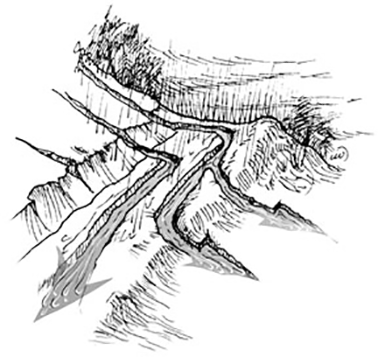Trail Erosion

The trail should “wear lightly on the land,” with minimal disturbance to the surroundings. The treadway should reflect a concern for safety, without detracting from the opportunity for hikers to experience wild and scenic lands by their own unaided efforts and without sacrificing aspects of the trail that may challenge their skill and stamina.
Warning Signs
The early stages of erosion are easy to spot. Gravel and pebbles cover the center of the treadway after leaf litter, clay, silt, and sand have been washed away. In the worst cases, the center of the trail becomes a jumble of stones and boulders, all smaller particles having been washed downhill.
Veteran trail maintainers maintain that the first maintenance priority is “water management.” In fact, this is most often “water mitigation”—keeping erosion from destroying the treadway by diverting water from the trail as soon as possible. Maintainers and hikers look for:
| Eroding tread | Soil washes out into a gully. Compaction alone may cause a 2 – 4-inch gully. If a gully is deeper than that, with silt particles and loose rocks in the gully, it is actively eroding. |
| Widening trail | Trampling of vegetation bordering the treadway, and consequent trail widening, may precede or follow the formation of a gully caused by erosion. |
| Divided trail | Multiple treadways worn by hikers bypassing poor footing or water running in the treadway are undesirable. |
| Running water | Water running down the treadway, especially in good weather, is a problem. |
| Breaking down | Soil breaking down on the outside edge of a graded foot path, causing the treadway to narrow, indicates a problem. |
| Gullied tread | Gullies on a graded sidehill, causing water to run down the trail, rather than off the outsloping edge, indicate an erosion problem. |
| Short-cut trail | Switchback shortcuts—woodland vegetation is trampled and soil eroded—are most undesirable. |
| Clogged devices | Clogged waterbars or grade dips that no longer divert water from treadway need to be repaired. |
| Deteriorated devices | Loose waterbars, steps, or cribs. |
| Loosened devices | Cribs or steps not retaining soil. |
| Collapsing device | Cribs dislodged by saplings. |
How Does This Happen?
Clay is made of very fine particles that, once broken from the ground, are easily washed away. Much of the treadway is built on mineral soil bound together by clay. The chemical bond of clay is hard to break—but fast-moving water does it.
“Thick” water flows faster than “thin” water. Water flowing in rivulets or ruts is thick water; water flowing across the trail in a sheet is thin water. Water flowing along the trail generally picks up volume (thickness) from new water flowing onto the trail and, thus, speed.
 Thick Water Thick Water |
 Thin Water Thin Water |
Gravity works. The ability of water to carry soil particles increases dramatically as it goes faster; water moving at 2 miles per hour has sixty-four times more ability to carry soil particles than water moving at 1 mile per hour.
 South Shenandoah
South Shenandoah